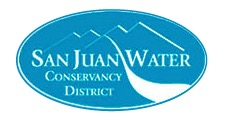San Juan Headwaters Forest Health Partnership (SJHFHP) and Mountain Studies Institute (MSI) installed new snowtography measurement equipment on Jackson Mountain in San Juan Water Conservancy District. Snow data will be collected this winter. Alex Handloff, the newly hired coordinator for San Juan Headwaters Forest Health Partnership, described the project to San Juan Water Conservancy District at its Special Meeting on November 16, 2023.
According to Handloff, there’s an emerging snowtography network happening in Colorado and across the West. Snowtography will inform decisions on how to manage forests and answer questions such as how the amount and location of trees impacts snow accumulation, retention, and ablation (melting/sublimating). With a changing climate, measuring and modeling the amount of snow we receive can support decisions to ensure water resources and ecosystem health, and in turn, our health. Eventually, data gleaned from snowtography can help determine how we approach forest health, wildfire mitigation, and riparian restoration. Snow provides between 75 and 90 percent of our water supply, says Handloff.
Dr. Jake Kurzwell, Mountain Studies Institute, is quoted in a recent article by Handloff published in the Pagosa Springs Sun: “Snowtography is an approachable method to quantify how forest structure and forest management impacts snow accululation, retention, and subse1quent water yields.”
Other Snowtography sites in the San Juan Mountains of southwest Colorado include Chicken Creek, Horse Creek, Lizard Head, and Red Mountain.
In addition to Snowtography, SJHFHP and MSI are involved in bringing two related scientific pursuits to Archuleta County: Adaptive Silvaculture for Climate Change and Collaborative Forest Landscape Restoration Projects.
Connect here to learn more: https://sanjuanheadwaters.org/forest-health-protection/snowtography/. Contact alex@mountainstudies.org to learn more and volunteer.
